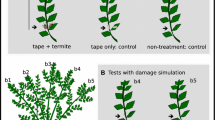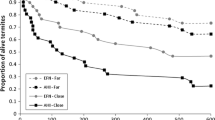Summary
The effect of defence force size in colonies of the ant Azteca muelleri on the time spent to localize, attack and expel the specialized herbivorous beetle Coelomera ruficornis from Cecropia pachystachya bushes was studied in an area of Atlantic forest in northeastern Brazil. Our results show that Azteca muelleri expel Coelomera ruficornis from Cecropia pachystachya and that the number of ants leaving a colony (defence force size) is negatively correlated with the residence time of an adult beetle on the plant. Colonies with larger defence forces recruited larger numbers of ants, resulting in faster herbivore discovery (r 2=0.80; n=17; P<0.001) and reduced herbivore residence time on a leaf (r 2=0.79 n=23; P<0.001) before being driven off by the ants. We also found a negative and significant relationship between herbivore damage on leaves and ant colony size (r 2=0.28; n=17; P<0.05). We conclude that larger colonies have more individuals available to patrol a plant and recruit defenders toward herbivores. This reduces the time spent to locate and expel susceptible herbivores from the plant. Since the plant probably benefits from reduced herbivory and the plant provides food for the ants, the association between Azteca muelleri and Cecropia pachystachya appears mutualistic.
Similar content being viewed by others
References
Andrade JC, Carauta JPP (1982) The Cecropia-Azteca association: A case of mutualism? Biotropica 14:15
Harada AY (1989) Estrutura de colônias de Azteca alfari Emery (Hymenoptera, Formicidae, Dolichoderinae) em plantas de Cecropia concolor (Moraceae). Rev Bras Entomol 33: 169–182
Holdridge LR, Grenke WC, Hatheway WH, Liang T, Tosi JS Jr (1971) Forest environments in tropical life zones: a pilot study. Pergamon Press, New York
Janzen DH (1969) Allelopathy by myrmecophytes: the ant Azteca as an allelopathic agent of Cecropia. Ecology 50: 147–153
Janzen DH (1973) Dissolution of mutualism between Cecropia and its Azteca ants. Biotropica 5: 15–28
Longino JT (1989) Geographic variation and community structure in an ant-plant mutualism: Azteca and Cecropia in Costa Rica. Biotropica 21: 126–132
Luizão FJ, Carvalho RMF (1981) Estimativa da biomassa de raízes de duas espécies de Cecropia e sua relação com a associação ou não das plantas a formigas. Acta Amazonica 11: 93–96
Rickson FR (1976) Glycogen plastids in Mullerian body cells of Cecropia peltata — a higher green plant. Science 173: 344–347
Rickson FR (1976) Anatomical development of the leaf trichilium and Mullerian bodies of Cecropia peltata L. Am J Bot 63: 1266–1271
Rickson FR (1977) Progressive loss of ant-related traits of Cecropia peltata on selected Caribbean islands. Am J Bot 64: 585–592
Schupp EW (1986) Azteca protection of Cecropia: ant occupation benefits juvenile trees. Oecologia 70: 379–385
Vinha SG, Lobão DEVP (1989) Estação Ecológica do Pau-Brasil, Porto Seguro, Bahia. CEPLAC, Centro de Pesquisas do Cacau, Bahia
Zar JH (1984) Biostatistical analysis, 2nd edn. Prentice-Hall, Englewood Cliffs, New Jersey
Author information
Authors and Affiliations
Rights and permissions
About this article
Cite this article
Rocha, C.F.D., Bergallo, H.G. Bigger ant colonies reduce herbivory and herbivore residence time on leaves of an ant-plant: Azteca muelleri vs. Coelomera ruficornis on Cecropia pachystachya . Oecologia 91, 249–252 (1992). https://doi.org/10.1007/BF00317792
Received:
Accepted:
Issue Date:
DOI: https://doi.org/10.1007/BF00317792




